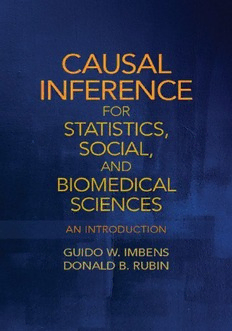
Causal Inference for Statistics, Social, and Biomedical Sciences: An Introduction PDF
Preview Causal Inference for Statistics, Social, and Biomedical Sciences: An Introduction
CAUSAL INFERENCE forStatistics, Social,and Biomedical Sciences AnIntroduction Mostquestionsinsocialandbiomedicalsciencesarecausalinnature:whatwould happentoindividuals,ortogroups,ifpartoftheirenvironmentwerechanged?In thisgroundbreakingtext,twoworld-renownedexpertspresentstatisticalmethods forstudyingsuchquestions. Thisbookstartswiththenotionofpotentialoutcomes, eachcorresponding to theoutcomethatwouldberealizedifasubjectwereexposedtoaparticulartreat- mentorregime.Inthisapproach,causaleffectsarecomparisonsofsuchpotential outcomes. The fundamental problem of causal inference is that we can observe only one of the potential outcomes for a particular subject. The authors discuss how randomized experiments allow us to assess causal effects and then turn to observational studies. They layout the assumptions needed for causal inference anddescribetheleadinganalysismethods,includingmatching,propensity-score methods, and instrumental variables. Many detailed applications are included, withspecialfocusonpracticalaspectsfortheempiricalresearcher. GuidoW.ImbensisAppliedEconometricsProfessorandProfessorofEconomics attheGraduateSchoolofBusinessatStanfordUniversity.Hehasprevioulsyheld tenuredpositionsattheUniversityofCaliforniaatLosAngeles,theUniversityof CaliforniaatBerkeley,andHarvardUniversity.HeisaFellowoftheEconometric Society and the American Academy of Arts and Sciences. He holds an hon- orarydoctoratefromtheUniversityofSt.Gallen,Switzerland.Imbenshasdone extensiveresearchineconometricsandstatistics,specializingincausalinference. He has published widelyin leadingeconomics and statisticsjournals, including the American Economic Review, Econometrica, the Review of Economic Stud- ies, theJournal oftheAmericanStatisticalAssociation, theAnnals ofStatistics, Biometrika,andtheJournaloftheRoyalStatisticalSociety,SeriesA. Donald B. Rubin is John L. Loeb Professor of Statistics at Harvard University, where he has been professor since 1983 and Department chair for 13 of those years. He has been elected to be a Fellow/Member/Honorary Member of the Woodrow Wilson Society, the Guggenheim Memorial Foundation, the Alexan- dervonHumboldtFoundation,theAmericanStatisticalAssociation,theInstitute of Mathematical Statistics, the International Statistical Institute, the American AssociationfortheAdvancementofScience,theAmericanAcademyofArtsand Sciences, the European Association of Methodology, the British Academy, and theU.S.NationalAcademyofSciences.Asof2014,hehasauthored/coauthored nearly400publications(includingtenbooks),hasfivejointpatents,andformany yearshasbeenone of themost highlycitedauthors intheworld, withcurrently over 150,000 citations (Google Scholar). He is also the recipient of honorary doctorates from Otto Friedrich University, Bamberg, Germany; the University of Ljubljana, Slovenia; and Universidad Santa To´mas, Bogota´, Colombia, and hasbeennamedanhonoraryprofessoratfouruniversities. AdvancePraiseforCausalInferenceforStatistics,Social,and BiomedicalSciences “Thisthoroughandcomprehensivebookusesthe‘potentialoutcomes’approachtocon- nect the breadth of theory of causal inference to the real-world analyses that are the foundation of evidence-based decision making in medicine, public policy, and many otherfields. ImbensandRubinprovideunprecedentedguidancefor designingresearch oncausalrelationships,andforinterpretingtheresultsofthatresearchappropriately.” –Dr.MarkMcClellan,DirectoroftheHealthCareInnovation andValueInitiative,theBrookingsInstitution “Clarityofthinkingaboutcausalityisofcentralimportanceinfinancialdecisionmaking. ImbensandRubinprovidearigorousfoundationallowingpractitionerstolearnfromthe pioneersinthefield.” –DrStephenBlyth,ManagingDirector,HeadofPublicMarkets, HarvardManagementCompany “A masterful account of the potential outcomes approach to causal inference from observationalstudiesthatRubinhasbeendevelopingsincehepioneeredit40yearsago.” –AdrianRaftery,Blumstein-JordanProfessorofStatisticsandSociology, UniversityofWashington “Correctlydrawingcausalinferencesiscriticalinmanyimportantapplications.Congrat- ulationstoProfessorsImbensandRubin,whohavedrawnontheirdecadesofresearchin thisarea,alongwiththeworkofseveralothers,toproducethisimpressivebookcovering concepts, theory, methods, and applications. I especiallyappreciate their clear exposi- tion of conceptual issues, which are important to understand in the context of either a designed experiment or an observational study, and their use of real applications to motivatethemethodsdescribed.” –NathanielSchenker,FormerPresidentoftheAmericanStatisticalAssociation CAUSAL INFERENCE for Statistics, Social, and Biomedical Sciences An Introduction Guido W. Imbens StanfordUniversity Donald B. Rubin HarvardUniversity 32AvenueoftheAmericas,NewYork,NY10013-2473,USA CambridgeUniversityPressispartoftheUniversityofCambridge. ItfurtherstheUniversity’smissionbydisseminatingknowledgeinthepursuitof education,learning,andresearchatthehighestinternationallevelsofexcellence. www.cambridge.org Informationonthistitle:www.cambridge.org/9780521885881 (cid:2)c GuidoW.ImbensandDonaldB.Rubin2015 Thispublicationisincopyright.Subjecttostatutoryexception andtotheprovisionsofrelevantcollectivelicensingagreements, noreproductionofanypartmaytakeplacewithoutthewritten permissionofCambridgeUniversityPress. Firstpublished2015 PrintedintheUnitedStatesofAmerica AcatalogrecordforthispublicationisavailablefromtheBritishLibrary. LibraryofCongressCataloginginPublicationData Imbens,Guido. Causalinferenceforstatistics,social,andbiomedicalsciences: anintroduction/GuidoW.Imbens&DonaldB.Rubin. pages cm 1. Socialsciences–Research. 2. Causation. 3. Inference. I. Rubin,DonaldB. II. Title. H62.I5372014 (cid:2) 519.54–dc23 2014020988 ISBN978-0-521-88588-1Hardback CambridgeUniversityPresshasnoresponsibilityforthepersistenceoraccuracyof URLsforexternalorthird-partyInternetWebsitesreferredtointhispublication anddoesnotguaranteethatanycontentonsuchWebsitesis,orwillremain, accurateorappropriate. Tomyparents,AnnieImbens-FransenandGerardImbens, foralltheirsupportandencouragementovertheyears;to mychildren,Carleton,AnnaliseandSylvia,whohave providedsomuchjoyinrecentyears;andtomywife andbestfriend,SusanAthey. GuidoW.Imbens Tomyfamily,colleagues,andstudents DonaldB.Rubin Contents Preface pagexvii PART I INTRODUCTION 1 Causality:TheBasicFramework 3 1.1 Introduction 3 1.2 PotentialOutcomes 3 1.3 DefinitionofCausalEffects 5 1.4 CausalEffectsinCommonUsage 7 1.5 LearningaboutCausalEffects:MultipleUnits 8 1.6 TheStableUnitTreatmentValueAssumption 9 1.7 TheAssignmentMechanism:AnIntroduction 13 1.8 Attributes,Pre-TreatmentVariables,orCovariates 15 1.9 PotentialOutcomesandLord’sParadox 16 1.10 CausalEstimands 18 1.11 StructureoftheBook 20 1.12 Samples,Populations,andSuper-Populations 20 1.13 Conclusion 21 Notes 21 2 ABriefHistoryofthePotentialOutcomesApproachto CausalInference 23 2.1 Introduction 23 2.2 PotentialOutcomesandtheAssignmentMechanism beforeNeyman 24 2.3 Neyman’s(1923)PotentialOutcomeNotationinRandomized Experiments 25 2.4 EarlierHintsforPhysicalRandomizing 26 2.5 Fisher’s(1925)ProposaltoRandomizeTreatmentstoUnits 26 2.6 TheObservedOutcomeNotationinObservationalStudiesfor CausalEffects 27 2.7 EarlyUsesofPotentialOutcomesinObservationalStudiesin SocialSciences 28 vii viii Contents 2.8 PotentialOutcomesandtheAssignmentMechanismin ObservationalStudies:Rubin(1974) 29 Notes 30 3 AClassificationofAssignmentMechanisms 31 3.1 Introduction 31 3.2 Notation 33 3.3 AssignmentProbabilities 34 3.4 RestrictionsontheAssignmentMechanism 37 3.5 AssignmentMechanismsandSuper-Populations 39 3.6 RandomizedExperiments 40 3.7 ObservationalStudies:RegularAssignmentMechanisms 41 3.8 ObservationalStudies:IrregularAssignmentMechanisms 42 3.9 Conclusion 43 Notes 43 PART II CLASSICAL RANDOMIZED EXPERIMENTS 4 ATaxonomyofClassicalRandomizedExperiments 47 4.1 Introduction 47 4.2 Notation 48 4.3 BernoulliTrials 48 4.4 CompletelyRandomizedExperiments 50 4.5 StratifiedRandomizedExperiments 51 4.6 PairedRandomizedExperiments 52 4.7 Discussion 53 4.8 Conclusion 55 Notes 56 5 Fisher’sExactP-ValuesforCompletelyRandomizedExperiments 57 5.1 Introduction 57 5.2 ThePauletal.HoneyExperimentData 59 5.3 ASimpleExamplewithSixUnits 59 5.4 TheChoiceofNullHypothesis 63 5.5 TheChoiceofStatistic 64 5.6 ASmallSimulationStudy 72 5.7 IntervalEstimatesBasedonFisherP-ValueCalculations 74 5.8 ComputationofP-Values 75 5.9 FisherExactP-ValueswithCovariates 78 5.10 FisherExactP-ValuesfortheHoneyData 80 5.11 Conclusion 81 Notes 81 6 Neyman’sRepeatedSamplingApproachtoCompletely RandomizedExperiments 83 6.1 Introduction 83 6.2 TheDuflo-Hanna-RyanTeacher-IncentiveExperimentData 84 6.3 UnbiasedEstimationoftheAverageTreatmentEffect 85 Contents ix 6.4 TheSamplingVarianceoftheNeymanEstimator 87 6.5 EstimatingtheSamplingVariance 92 6.6 ConfidenceIntervalsandTesting 95 6.7 InferenceforPopulationAverageTreatmentEffects 98 6.8 Neyman’sApproachwithCovariates 101 6.9 ResultsfortheDuflo-Hanna-RyanTeacher-IncentiveData 102 6.10 Conclusion 104 Notes 104 AppendixASamplingVarianceCalculations 105 AppendixBRandomSamplingfromaSuper-Population 109 7 RegressionMethodsforCompletelyRandomizedExperiments 113 7.1 Introduction 113 7.2 TheLRC-CPPTCholesterolData 115 7.3 TheSuper-PopulationAverageTreatmentEffects 116 7.4 LinearRegressionwithNoCovariates 118 7.5 LinearRegressionwithAdditionalCovariates 122 7.6 LinearRegressionwithCovariatesandInteractions 125 7.7 TransformationsoftheOutcomeVariable 127 7.8 TheLimitsonIncreasesinPrecisionDuetoCovariates 128 7.9 TestingforthePresenceofTreatmentEffects 129 7.10 EstimatesforLRC-CPPTCholesterolData 131 7.11 Conclusion 133 Notes 134 Appendix 135 8 Model-BasedInferenceforCompletelyRandomizedExperiments 141 8.1 Introduction 141 8.2 TheLalondeNSWExperimentalJob-TrainingData 144 8.3 ASimpleExample:NaiveandMoreSophisticatedApproaches toImputation 146 8.4 BayesianModel-BasedImputationintheAbsenceofCovariates 150 8.5 SimulationMethodsintheModel-BasedApproach 163 8.6 DependencebetweenPotentialOutcomes 165 8.7 Model-BasedImputationwithCovariates 169 8.8 Super-PopulationAverageTreatmentEffects 171 8.9 AFrequentistPerspective 172 8.10 Model-BasedEstimatesoftheEffectoftheNSWProgram 174 8.11 Conclusion 177 Notes 177 AppendixAPosteriorDistributionsforNormalModels 178 AppendixBAnalyticDerivationswithKnownCovariance Matrix 181 9 StratifiedRandomizedExperiments 187 9.1 Introduction 187 9.2 TheTenneseeProjectStarData 188
